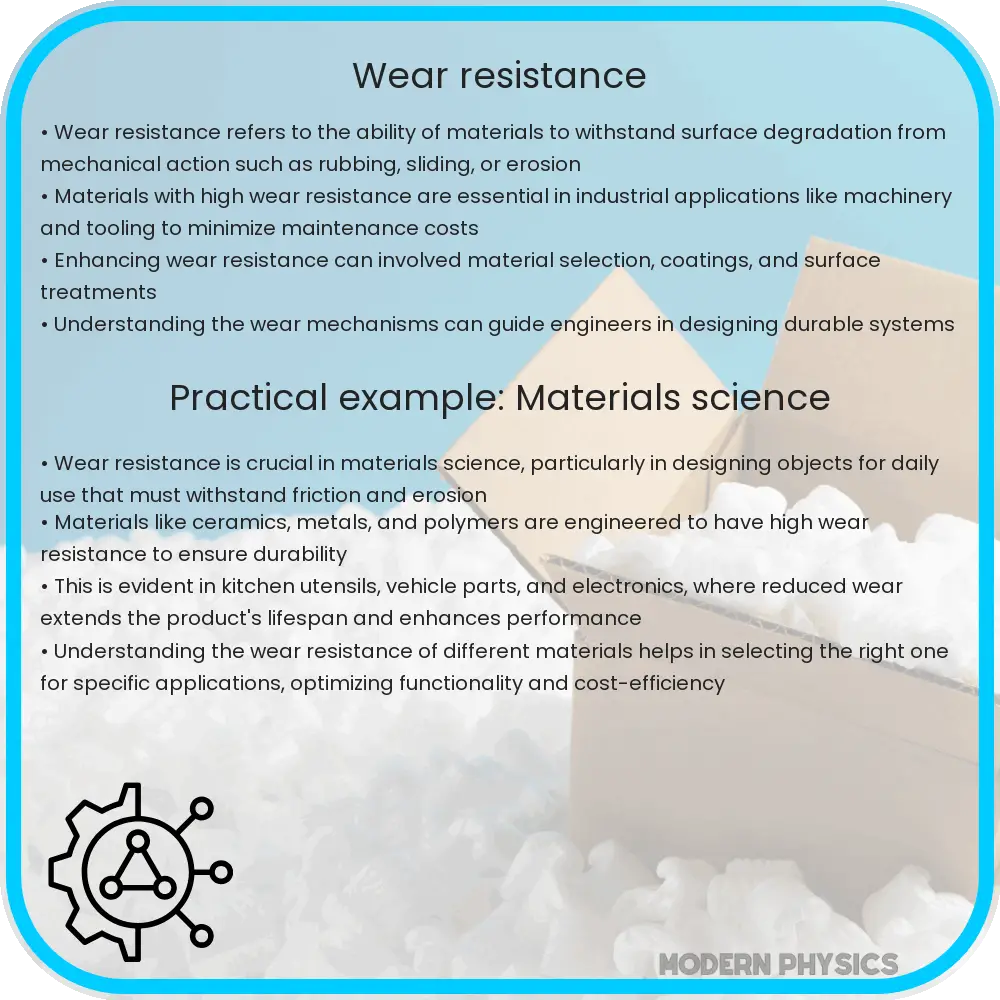Learn about wear resistance, its significance in material durability, and its role in engineering design for optimal component performance.

Understanding Wear Resistance in Materials
Wear resistance refers to the ability of a material to withstand damage caused by friction and mechanical wear. This characteristic is crucial in the design and engineering of components that must endure continuous or frequent contact with other materials. In this article, we delve into the essentials of wear resistance, exploring its impact on material durability and the principles behind the selection of materials in engineering designs.
Basics of Wear Resistance
Wear resistance is largely influenced by both the properties of the material and the operating conditions. The key material properties impacting wear resistance include hardness, toughness, and the presence of specific microstructures. Operating conditions that affect wear include the type of motion (e.g., sliding, rolling), the presence of abrasive particles, and the environmental temperature and chemistry.
- Hardness: Typically, harder materials can resist wear better than softer ones because they are less susceptible to indentation and material deformation.
- Toughness: Tough materials can absorb significant energy before failing, making them more resistant to fracturing from impact during wear processes.
- Microstructure: The arrangement of grains and phases within a material can significantly influence wear characteristics. For example, a well-dispersed secondary phase can block the motion of dislocations or enhance load distribution, thus improving wear resistance.
Types of Wear
Understanding different types of wear is essential to selecting appropriate materials for specific applications. The primary types of wear include:
- Adhesive Wear: Occurs when materials transfer from one surface to another due to solid-phase welding at contact points under load, commonly seen in metal sliding against metal.
- Abrasive Wear: Happens when hard particles or hard protuberances force against and move along a solid surface.
- Corrosive Wear: Involves chemical or electrochemical reaction with the environment, which can degrade the material.
- Erosive Wear: Caused by the impact of solid particles or liquid droplets on a surface.
Each type of wear poses unique challenges and dictates the specific properties that a material must have to effectively resist wear under certain conditions. By understanding the applications and the types of wear involved, engineers can better design materials that balance wear resistance with other necessary attributes such as manufacturability, cost, and weight.
Materials Engineering and Design
Material selection for wear-resistant applications involves a comprehensive understanding of both material properties and the intended application’s demands. Engineers often begin with baseline materials known for their high wear resistance, such as carbides or advanced ceramics, and tailor them through alloying, heat treatment, or composite design to meet specific needs.
Additionally, surface engineering techniques such as coatings, thermal spraying, or surface hardening are employed to enhance the wear resistance of existing materials. These techniques can be particularly cost-effective, as they allow the use of less expensive substrates with wear-resistant surfaces.
Incorporating computational tools and simulations in the design process also plays a pivotal role in predicting wear and optimizing material selection. Simulations can predict how materials will respond to different types of wear, allowing adjustments to material compositions or processing methods before physical prototypes are made.
Through the informed application of materials science, engineering principles, and advanced technologies, it is possible to design materials that stand up to even the most challenging wear conditions, extending the lifespan of components and reducing the need for frequent replacements, which is crucial in engineering applications across various industries.
Case Studies in Wear Resistance
Real-world applications of wear-resistant materials illuminate the importance and effectiveness of properly engineered solutions. For instance, in the aerospace industry, components such as turbine blades are subjected to both high temperatures and erosive wear from airborne particles. Advanced ceramics and heat-resistant superalloys are used to withstand these conditions, prolonging the life of aircraft engines and enhancing efficiency.
In the automotive industry, wear resistance is critical in the design of piston rings and bearings. These components are optimized using materials such as advanced polymers and coated metals that must endure extreme pressures and variable temperatures without failing.
- Construction and Mining Equipment: High-strength steels are enhanced with carbide reinforcements to resist the wear caused by abrasive rocks and soils.
- Sports Equipment: Consider the evolution of tennis racket strings made from wear-resistant fibers that withstand hundreds of high-velocity impacts with sharp angular motions.
Each of these examples showcases how targeted material enhancements and innovative design techniques can drastically improve the durability and functionality of critical components in their respective fields.
Environmental and Economic Impact
Enhancing the wear resistance of materials also contributes to environmental sustainability. By extending the life of products, the need for frequent replacements is reduced, thereby curbing waste and minimizing resource consumption. This sustainable approach also aligns with economic goals by decreasing long-term operational and maintenance costs.
Furthermore, companies that adopt advanced wear-resistant technologies often gain competitive advantages, as they can offer longer-lasting, more reliable products to their customers.
Conclusion
Wear resistance is a critical facet of material science that plays a vital role in a wide range of engineering applications. From everyday objects to sophisticated industrial machinery, the ability of a material to withstand wear not only extends its service life but also enhances performance and efficiency. The ongoing development of new materials and technologies promises to further the capabilities of wear-resistant designs, benefiting industries and consumers alike. As engineers continue to push the boundaries in materials science, the future of wear-resistant materials looks robust and promising, signaling a path toward more durable and sustainable engineering solutions.
Ultimately, the strategic application of wear-resistant materials not only addresses practical design challenges but also contributes significantly to global sustainability efforts, making it an essential consideration in the evolving landscape of materials engineering.
